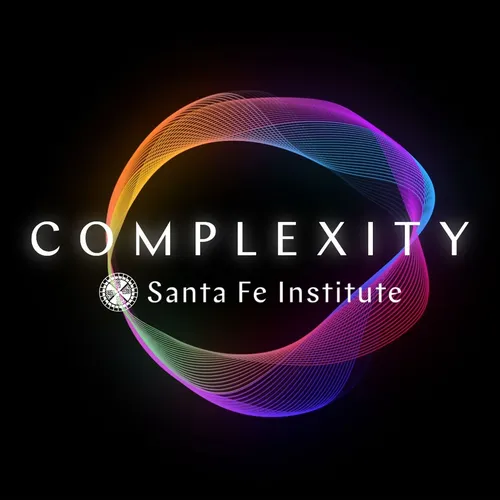
COMPLEXITY
The official podcast of the Santa Fe Institute. Subscribe now and be part of the exploration!
- Update frequency
- every 12 days
- Average duration
- 56 minutes
- Episodes
- 119
- Years Active
- 2019 - 2024

Andrea Wulf on The Invention of Nature, Part 1: Humboldt's Naturegemälde
When you hear the word “nature,” what comes to mind? Chances are, if you are listening to this in the 21st Century, the image is one of a vast, interconnected, living network — one in which you and y…

Sidney Redner on Statistics and Everyday Life
Complexity is all around us: in the paths we walk through pathless woods, the strategies we use to park our cars, the dynamics of an elevator as it cycles up and down a building. Zoom out far enough …

Orit Peleg on the Collective Behavior of Honeybees & Fireflies
“More than the sum of its parts” is practically the slogan of systems thinking. One canonical example is a beehive: individually, a honeybee is not that clever, but together they can function like sh…

Jonas Dalege on The Physics of Attitudes & Beliefs
Human relationships are often described in the language of “chemistry” — does that make the beliefs and attitudes of individuals a kind of “physics”? It is, at least, a fascinating avenue of inquiry.…

J. Doyne Farmer on The Complexity Economics Revolution
Once upon a time at UC Santa Cruz, a group of renegade grad students started mixing physics with math and computers, determined to discover underlying patterns in the seeming-randomness of systems li…

James Evans on Social Computing and Diversity by Design
In the 21st Century, science is a team sport played by humans and computers, both. Social science in particular is in the midst of a transition from the qualitative study of small groups of people to…

David Stork on AI Art History
Art history is a lot like archaeology — we here in the present day get artifacts and records, but the gaps between them are enormous, and the questions that they beg loom large. Historians need to be…

Alien Crash Site Invades Complexity: Tamara van der Does on Sci-Fi Science, with Guest Co-host Caitlin McShea
The consequence of living in a complex world: one tiny tweak can lead to massive transformation. Set the stage a slightly different way, and the entire play might unfold differently. This path-depend…

Mark Moffett on Canopy Biology & The Human Swarm
Most maps of the world render landscapes in 2D — yet wherever we observe ecosystems, they stratify into a third dimension. The same geometries that describe the dizzying diversity of species in the c…

Cris Moore on Algorithmic Justice & The Physics of Inference
It’s tempting to believe that people can outsource decisions to machines — that algorithms are objective, and it’s easier and fairer to dump the burden on them. But convenience conceals the complicat…

Science in The Time of COVID: Michael Lachmann & Sam Scarpino on Lessons from The Pandemic
COVID-19 hasn’t just disrupted the “normal” of everyone’s social practices in what we take for granted as “daily life.” The pandemic has also, more granularly, changed the way scientists research and…

Artemy Kolchinsky on "Semantic Information" & The Physics of Meaning
Matter, energy, and information: the holy trinity of physics. Understanding the relations between these measures of our world are one of the big questions of complex systems science.
The laws of therm…

Peter Dodds on Text-Based Timeline Analysis & New Instruments for The Science of Stories
"There are decades where nothing happens; and there are weeks where decades happen.”
– Vladimir Ilyich Lenin
When human beings saw the first pictures of the Earth from space, the impact was transformat…

Scott Ortman on Archaeological Synthesis and Settlement Scaling Theory
The modern world has a way of distancing itself from everything that came before it…and yet the evidence from archaeology supports a different story. While industrial societies tend to praise markets…

Helena Miton on Cultural Evolution in Music and Writing Systems
Organisms aren’t the only products of the evolutionary process. Cultural products such as writing, art, and music also undergo change over time, subject to both the constraints of the physical enviro…

David Wolpert on The No Free Lunch Theorems and Why They Undermine The Scientific Method
On the one hand, we have math: a world of forms and patterns, a priori logic, timeless and consistent. On the other, we have physics: messy and embodied interactions, context-dependent and contingent…

Vicky Yang & Henrik Olsson on Political Polling & Polarization: How We Make Decisions & Identities
Whether you live in the USA or have just been watching the circus from afar, chances are that you agree: “polarization” dominates descriptions of the social landscape. Judging from the news alone, on…

Carl Bergstrom & Jevin West on Calling Bullshit: The Art of Skepticism in a Data-Driven World
Now, maybe more than ever before, it is time to learn the art of skepticism. Amidst compounded complex crises, humankind must also navigate a swelling tidal wave of outright lies, clever misdirectio…

Natalie Grefenstette on Agnostic Biosignature Detection
Is there life on Mars? Or Titan? What are we even looking for? Without a formal definition, inquiries into the stars just echo noise. But then, perhaps, the noise contains a signal… To find life else…

The Information Theory of Biology & Origins of Life with Sara Imari Walker (Big Biology Podcast Crossover)
One of the defining characteristics of complex systems science is the shift in emphasis from objects to relationships and processes. How is information related to matter and energy, and how do the di…